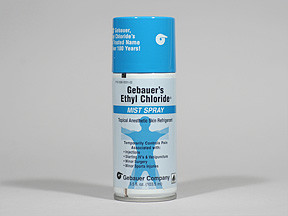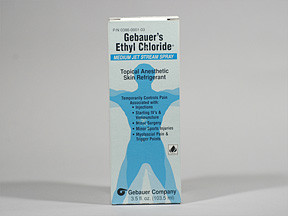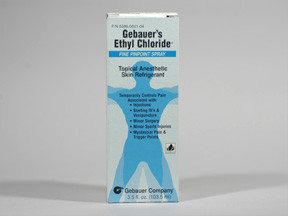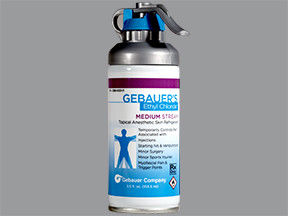ETHYL CHLORIDE SPRAY - TOPICAL
PHONETIC PRONUNCIATION: (ETH-ill KLOR-ide)
GENERIC NAME(S): ethyl chloride
Uses
USES: This medication is used to prevent pain caused by injections and minor surgical procedures. It is also used for the temporary relief of minor sports injuries. Ethyl chloride also helps to relieve deep muscle pain when used with muscle stretching techniques. Ethyl chloride is a cooling substance that is applied to the skin to numb it.
How to use ETHYL CHLORIDE SPRAY - TOPICAL
HOW TO USE: This medication is for use on the skin only. It is applied by a healthcare professional. Do not apply to broken skin or mucous membranes (e.g., inside the nose or mouth). Do not spray into the eyes. Do not inhale the spray. This medication is flammable. Do not use near an open flame or near electrical equipment that can spark a fire. Before applying ethyl chloride to injection and local surgical sites, your healthcare professional will swab the treatment area with an antiseptic. Petroleum jelly may be applied to protect surrounding areas around the surgical site. The ethyl chloride container should be positioned 3-9 inches (8-23 centimeters) away from the skin. If using ethyl chloride in a bottle, it should be held upside down and sprayed onto the area for 3-7 seconds. If using ethyl chloride in an aerosol can, it should be held upright and sprayed onto the area for 4-10 seconds. Your healthcare professional will spray just until the skin starts to turn white, stopping before the skin frosts. The procedure will then be quickly performed because the numbing effect of ethyl chloride only lasts for a few seconds to a minute. For the relief of deep muscle pain, the healthcare professional will hold the container 12-18 inches (30-46 centimeters) away from the muscle, then spray in a sweeping motion at the rate of 4 inches (10.2 centimeters) per second until the entire muscle is covered from the trigger point to the area of pain. The muscle will be slowly stretched during this process until full motion is restored and pain is relieved.
Side Effects
Precautions
Interactions
Overdose
Images
Reviews
Disclaimer
IMPORTANT: HOW TO USE THIS INFORMATION: This is a summary and does NOT have all possible information about this product. This information does not assure that this product is safe, effective, or appropriate for you. This information is not individual medical advice and does not substitute for the advice of your health care professional. Always ask your health care professional for complete information about this product and your specific health needs.




No Reviews Yet